Art Fairs
Warsaw’s New Collaborative Art Fair Debuts Amid an Upswing of Political Optimism in Poland
NADA Villa Warsaw is the latest addition to a growing list of alternative initiatives upending the traditional art fair model.
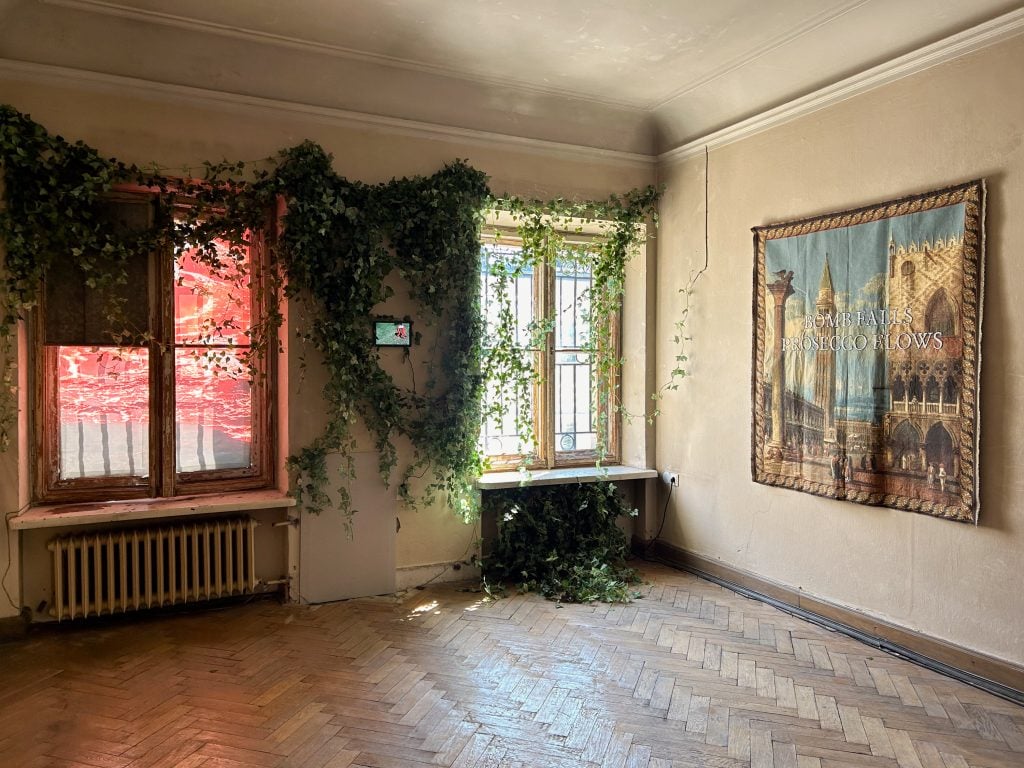
NADA Villa Warsaw is the latest addition to a growing list of alternative initiatives upending the traditional art fair model.

Aga Sablinska

This week, 44 galleries from 25 cities will take over Warsaw’s historic Villa Gawrońskich for the inaugural edition of NADA Villa Warsaw. The five-day collaborative selling exhibition, which is free and open to the public through May 19, is the latest addition to a growing list of alternative initiatives upending the traditional art fair model. Moreover, it arrives in the Polish capital at a hopeful political moment and brings with it a surge of optimism for the city’s culture scene.
The event is the result of years of dialogue between Heather Hubbs, the executive director of the New Art Dealers Alliance (NADA), and three Warsaw-based gallerists: Michał Kaczyński, the director of Raster; LETO Gallery’s Marta Kołakowska; and Joanna Witek-Lipka, who helms Warsaw Gallery Weekend. It combines the concepts of Villa Raster, an art fair alternative spearheaded by Kaczyński and organized in cities including Reykjavik, Tokyo, and Toronto since 2006, and NADA House, held every summer in the historic houses of Colonels Row on Governors Island in New York City.
NADA Villa Warsaw’s launch comes just seven months after the surprising results of last October’s elections in which the right-wing conservative Law and Justice party lost its majority after eight years of rule. Since the election, arts and culture institutions across Poland have been working to reverse the party’s undue and often undemocratic moves, which included unjustly firing the heads of several museums and other cultural institutions.
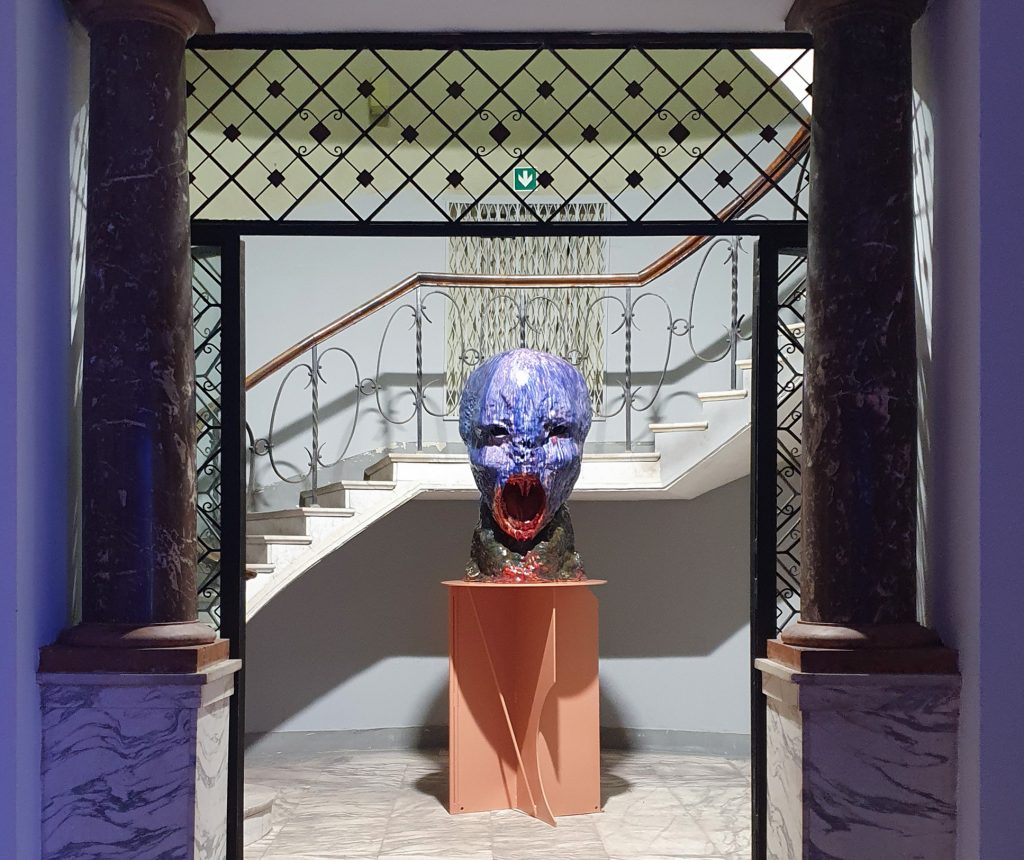
Installation view Olaf Brzeski’s Vampire (2024). Courtesy of Raster Gallery and NADA.
“It was during the difficult political times and Poland’s distancing from democracy that we in Poland felt we must act independently and use art to help our society,” Kaczyński said of the group’s decision to found NADA Villa Warsaw. He added that its launch has now “become part of this optimism” sweeping the country after other recent positive cultural changes, including the fact that just last week, Hanna Wróblewska, the longtime director of the Zachęta National Gallery of Art whose unjust termination by Law and Justice in 2021 was met with widespread disapproval from the international arts community, became Poland’s new Minister of Culture.
Despite the positive political and cultural shifts in Poland, the geopolitical climate of Eastern Europe remains tense. War rages just across Poland’s border in Ukraine as Russia’s invasion, launched in February 2022, continues to pose a threat to the entire region. As NADA Villa Warsaw is one of the biggest art events in the region, the war and other geopolitical issues seep through the exhibition.
For instance, Fragment, the New York-based gallery founded by Russian expat Sergey Guschin, is showing a series of works by the Russian-born, London-based artist Dagnini called “Notes on the Apocalypse,” including the tapestry work On the Opening of the 60th Venice Biennale, a commentary on the recent art world event embroidered with the words “BOMB FALLS PROSECCO FLOWS.”
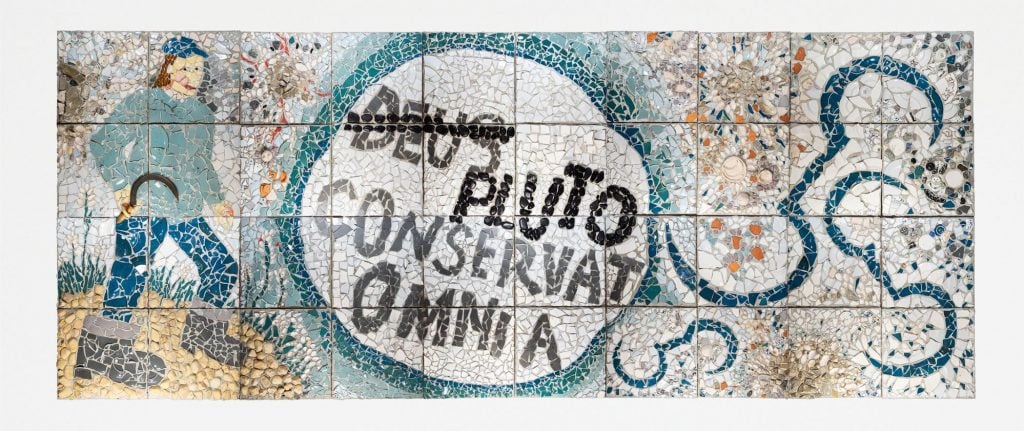
Deus Pluto conservat omnia by Alexey Lunev, Małgorzata Mycek, Raman Tratsiuk, Katarzyna Wojtczak at BWA Warszawa. Courtesy of the artist and NADA.
The Warsaw-based gallery BWA Warszawa presents a collaborative mosaic project by LGBTQ+ artists from Poland and Belarus—including Małgorzata Mycek, Alexey Lunev, Raman Tratsiuk, and Katarzyna Wojtczak—in which they use the mosaic technique to celebrate the queer community, who are marginalized and even criminalized in some countries in East-Central Europe.
Meanwhile, Tbilisi’s Why Not Gallery presents a series of tapestries by the young Georgian artist Gvantsa Jishkariani, including History of Pain, which blends traditional craft techniques and folk imagery with contemporary social issues. These works have taken on added poignancy considering that Georgia’s parliament passed the Kremlin-inspired “foreign interests” bill this week. Many critics consider the bill a threat to the country’s democratic freedoms and its desire to join the European Union, and its contentious approval came after weeks of large-scale public protests.
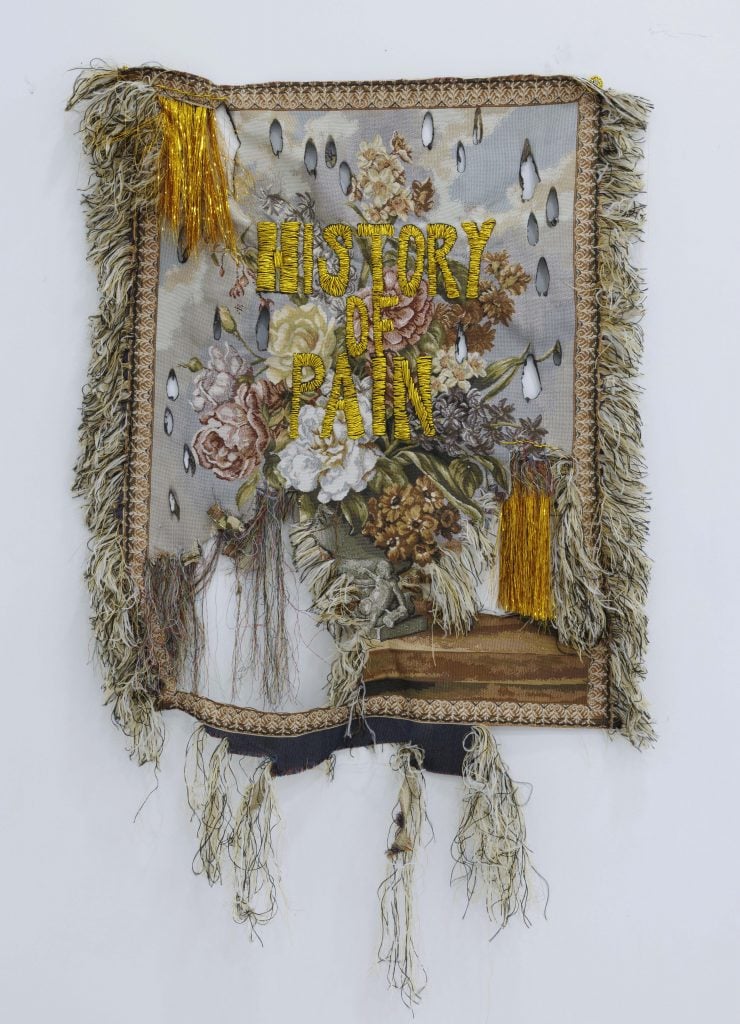
Gvantsa Jishkariani’s History of Pain (2024), brought by The Why Not Gallery, Tbilisi. Courtesy of the gallery and NADA.
While many of the works deal with tense sociopolitical issues, NADA Villa Warsaw is ultimately a celebration of collaboration and creativity that was designed for the public to “experience the vibrancy and energy of the contemporary art scene in our region,” Kołakowska said. Unlike your average art fair, galleries share rooms and other spaces in Villa Gawrońskich, a neo-baroque architectural landmark that was chosen for its distinctive character, interesting architecture, and central location in the capital city.
The exhibition features work by some of the best-known Polish artists working today—such as Paweł Althamer, whose sculptures are brought by Foksal Gallery, and Joanna Rajkowska, presented by lokal_30, as well as international names, like the American painter Mira Dancy, presented by Dio Horia from Athens.

Installation view of Przemek Pyszczek’s works at Fierman. Courtesy of the gallery and NADA.
Many lesser-known artists, including several from the region’s global diaspora, are another highlight of NADA Villa Warsaw. These include the Polish-Canadian artist Przemek Pyszczek, whose playful wall sculptures are being show by the New York-based gallery Fierman. The artist’s Playground Structure series nods to the post-communist trend of pouring colorful veneers over Soviet-era infrastructure and architecture across East-Central Europe.
Most participating galleries are veterans of NADA’s fairs in New York and Miami—some, like Polana Institute, BWA Warszawa, and Fierman. even participated in NADA New York just last week. Others, like the New York-based gallerist Alyssa Davis, are making their NADA debut in Warsaw. Davis said she “appreciated what felt like an unconventional choice of a city for NADA” as well as the fact that the event “isn’t a traditional art fair but more of a collective exhibition in an interesting setting.”
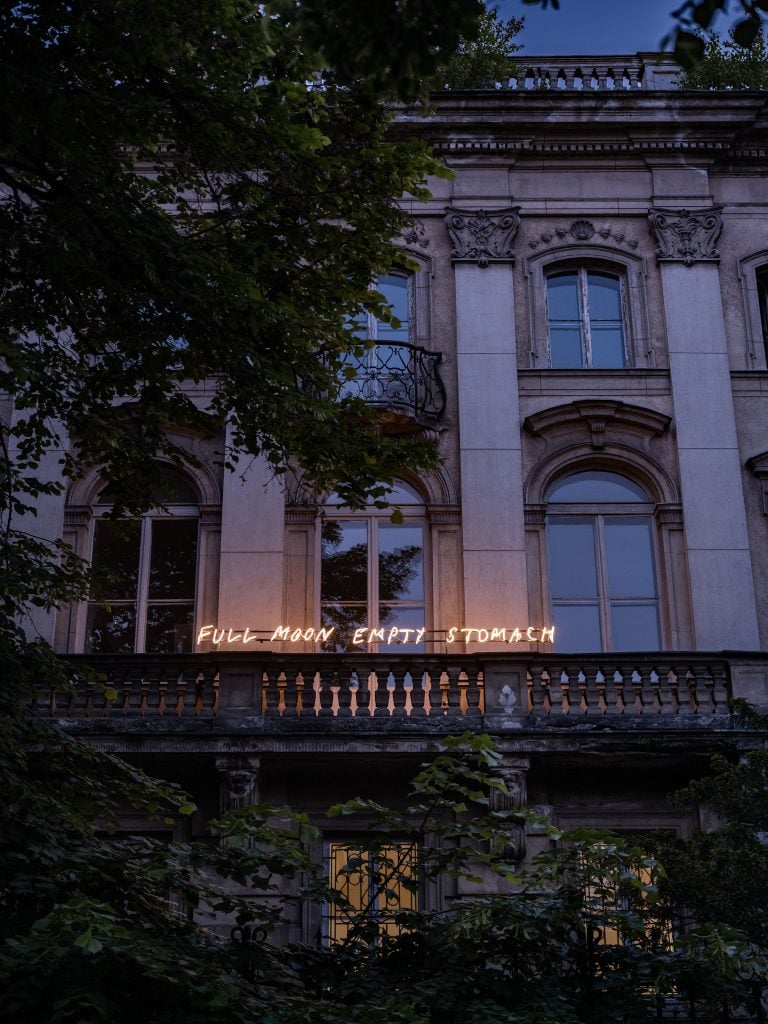
Villa Gawronskich’s exterior with Flaviu Cacoveanu’s neon Full Moon Empty Stomach displayed. Courtesy of NADA.
Despite the fact that it is not mandatory for exhibiting gallerists to be present, another way in which the Villa differs from a typical fair, Davis said she had “always been interested in visiting Warsaw, especially after hearing how active the scene is there.”
“NADA Villa Warsaw is exciting for me personally as it is an initiative that is member-driven,” Hubbs said, noting that she visited the Polish capital during Warsaw Gallery Weekend last year. “It was a cool way for us to collaborate with members in a faraway place… We’re always looking for members to come to us with ideas like this,” she added.
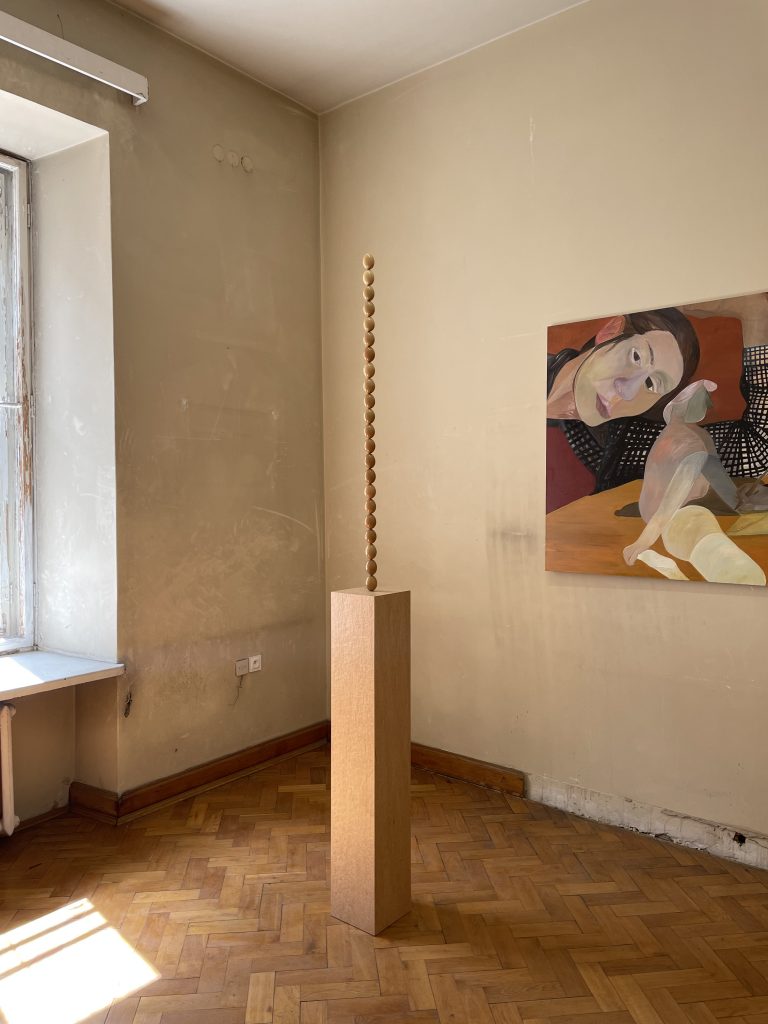
Installation view of Katarzyna Przezwańska’s egg tower (2024) and Dominika Kowynia’s To Suddenly Have a Body (2024). Courtesy of NADA.
While the mood among gallerists going into NADA Villa Warsaw could only be described as optimistic, a pairing of works by the Warsaw-based Polana Institute highlighted the delicate nature of this optimism. The gallery’s presentation of Katarzyna Przezwańska’s sculpture Egg Tower next to the young Polish painter Dominika Kowynia’s new work To Suddenly Have a Body seemed like a subtle curatorial urge for caution, reminding NADA Villa Warsaw’s visitors of the fragility of the region as well as the precarious nature of significant sociopolitical change.